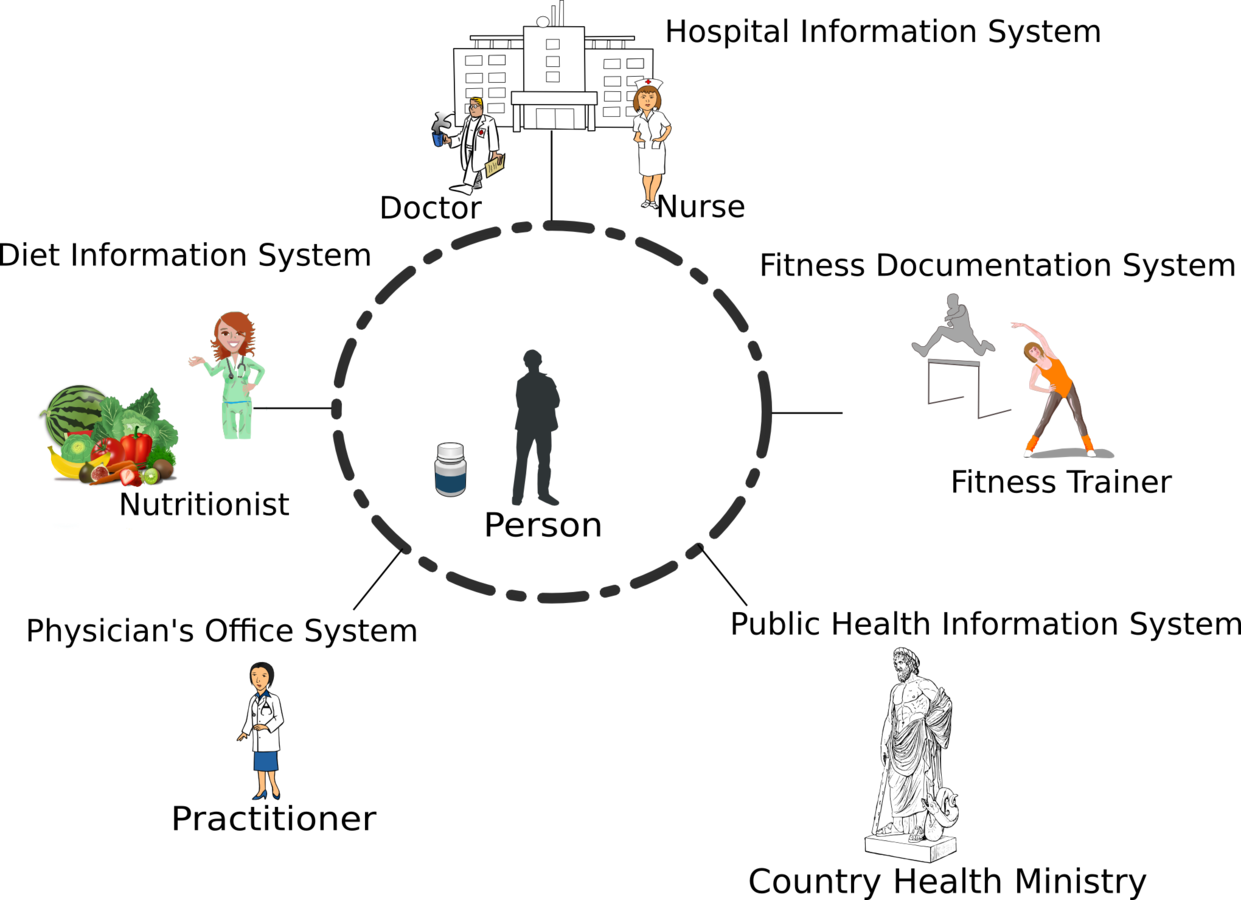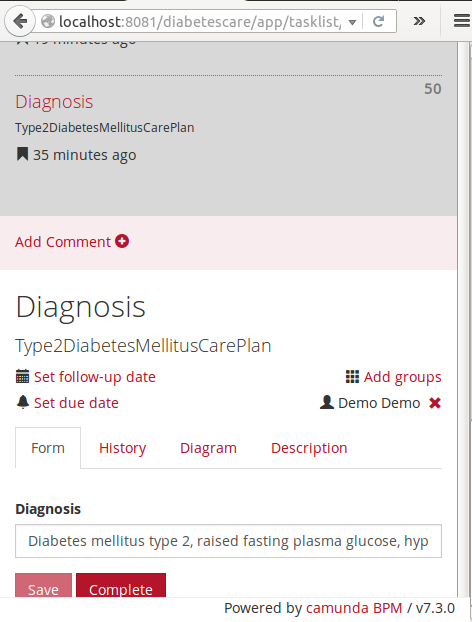An Architecture-Centric and Ontology-Based Approach to Cross-Domain Interoperability of Health Information Systems for Diabetes Care
PhD(c). Gustavo Andrés Uribe Gómez
PhD. Diego Mauricio López
PhD. Bernd Blobel


University of Regensburg

Introduction
1
Interoperability Challenge

2

Related Work

EHR, PHR and DSS
interoperability
(Booker and Trabulsi, 2009; Fahey, 2012; Osborn et al., 2010; Quinn et al., 2011; Schnipper et al., 2012; Wake and Cunningham, 2013; Santana, 2013)
3
Related Work

Semantic Interoperability
(Chungoora et al., 2013; Heywood et al., 2011; Sonsilphong and Arch-int, 2013; Tessier, 2011)
3
Related Work

Ontology-based systems
(Tessier, 2013; Archer et al. 2011; Sonsilphong et al., 2013, Snyder et al. 2013)
3
Related Work

Architecture-centric approach
(Oemig F and Blobel B., 2011; Health Level 7 International, 2013; Blobel B., Goossen W, Brochhausen M., 2012; Lopez DM and Blobel B, 2009)
3
Related Work
No single approach supports the following issues:
- Consideration of the cross-domain interoperability
- Consideration of the system architecture
- Adherence to policies and guidelines
- Decision support
- Knowledge management
- Knowledge formalization
- Inference
- Flexible and adaptable
- To add new actors
- To adapt to new rules or knowledge
4
Research Question
How to achieve cross-domain interoperability in health informatics systems for supporting Type 2 Diabetes Mellitus care?
5
Hypothesis
By using an architectural-centric approach to analyze, design and implement health information systems based on the Generic Component Model (GCM) and representing the components through ontologies it is possible to achieve cross-domain interoperability of health information systems supporting the diabetes care.
6
General Objective
Propose an approach to achieve interoperability of health information systems in the diabetes care
Specific Objectives
- Define formally and architecturally the system of diabetes care, its components and relationships.
- Define use case specific architectures for the relevant use cases in the diabetes care including the related actors.
- Develop a pilot software solution to support the relevant diabetes care use cases enabling interoperability.
- Evaluate the interoperability functionalities of the software solution developed
Methodology
7
Generic Component Model - GCM

(B.Blobel, 2012)
8
Generic Component Model - GCM

(B.Blobel, 2012)
8
Generic Component Model - GCM

(B.Blobel, 2012)
8
Generic Component Model - GCM

(B.Blobel, 2012)
RM - ODP
8
Business Process Modeling

Business Process Modeling Notation (BPMN)
- Graphical Notation
- Representation of computer independent elements
- Standardized
9
Formal Language for Describing Rules and Policies
SPARQL Inference Notation (SPIN)
- Compatible with OWL and RDF
- Standardized (Based on RDF)
- Provides an integrated development environment

10
Contributions
11
Contributions
A Generic Architecture for an Adaptive, Interoperable and Intelligent Type 2 Diabetes Mellitus Care System
Uribe, G. A., B. Blobel, D. M. López, and S. Schulz. "A generic architecture for an adaptive, interoperable and intelligent type 2 diabetes mellitus care system." Studies in health technology and informatics 211 (2015): 121. Categoria Colciencias A2
12
Generic Model of the T2DM Care System

13
GCM Representation of the Medical Domain


14-1
GCM Representation of the Policy Domain


14-2
GCM Representation of the Resource Domain


14-3
UML Representation of Cross-domain Relations


15-1
UML Representation of Medical Domain


15-2
UML Representation of Policy Domain


15-3
UML Representation of Resources Domain


Ontological Representation


16

Description of Business Process


17
Description of Processes at the Health Service Level


18-1
Description of Processes at the Disciplines Level


18-2
Description of Processes at the Tasks Level

18-3

Contributions
Specializing Architectures for the Type 2 Diabetes Mellitus Care Use Cases with a Focus on Process Management
Uribe, G. A., B. Blobel, D. M. López, and A. A. Ruiz. "Specializing architectures for the type 2 diabetes mellitus care use cases with a focus on process management." Studies in health technology and informatics 211 (2015): 132. Categoría Colciencias A2.
19
Main Interventions

Lifestyle intervention
Pharmacological intervention
20
Medical Domain in GCM


21-1
Policy Domain in GCM


21-2
Resource Domain in GCM


21-3
UML Cross-domain Model


22-1
UML Medical Model


22-2
UML Policy Model


22-3
UML Resource Model


Disciplines in the Glycemic Control


23-1
Observation Health Care Serive Process


23-2
Physical Examination Process


23-3
Hyperglycemia Alert Rule
CONSTRUCT {
?id btl2:isPartOf ?patientLife .
?id btl2:hasCondition ?id .
?id a dm2co:Hyperglycemia .
?id a dm2co:MedicalAlert .
?id rdfs:label ?cause_type_en .
?id rdfs:label ?cause_type_es .
?this btl2:represents ?id .
}
WHERE {
?patient btl2:isBearerOf ?blood_glucose .
?patient btl2:hasLife ?patientLife .
?this btl2:represents ?blood_glucose .
?blood_glucose a dm2co:BloodGlucoseConcentration .
?this dm2co:hasValueIn_mg_dL ?value .
FILTER ((?value >= 200.0) && (?value < 300.0)) .
OPTIONAL {
?clonAlert a dm2co:MedicalAlert .
?this btl2:represents ?clonAlert .
} .
FILTER (!bound(?clonAlert)) .
BIND (STRLANG("hyperglycemia medical alert", "en") AS ?cause_type_en) .
BIND (STRLANG("alerta médica por hiperglucemia", "es") AS ?cause_type_es) .
BIND (IRI(fn:concat("http://purl.org/unicauca/dm2co#", STRUUID())) AS ?id) .
}
24-1
Patient Safety Policy
# if physical examination is planned then handwashing is planned before
CONSTRUCT {
?this btl2:hasPart _:b0 .
_:b0 a bpmn:SequenceFlow .
_:b0 btl2:hasComponentPart _:b1 .
_:b1 a bpmn:SequenceFlow_Target .
_:b1 btl2:represents ?physical_examination_plan .
_:b0 btl2:hasComponentPart _:b2 .
_:b2 a bpmn:SequenceFlow_Source .
_:b2 btl2:represents _:b3 .
_:b3 a dm2co:HandwashingPlan .
}
WHERE {
?this btl2:hasPart ?physical_examination_plan .
?physical_examination_plan a dm2co:PhysicalExaminationPlan .
}
24-2
Contributions
Ontology-based and Model-driven Implementation of Health Information Systems. A Diabetes Mellitus Care System Use Case
Uribe, G. A., D. M. López and B. Blobel. "Ontology-based and Model-driven Implementation of Health Information Systems. A Diabetes Mellitus Care System Use Case ". To be submitted.
Uribe, G. A., D. M. Lopez, and B. Blobel. "Towards automated biomedical ontology harmonization." Studies in health technology and informatics 200 (2014): 62-68. Categoría Colciencias A2.
25
Implementation Methods

MDA
- Hard-coded logics
- Weak semantics
- Inflexible transformations
+ Computer Independent Models
+ Modeling of behavior
25-1
Implementation Methods


Semantic Web
- Difficulties for modeling of behavior
+ Computer Independent Models
+ Inference capabilities
26-2
Implementation Methods



Hybrid
+ Inference capabilities
+ Computer Independent Models
+ Modeling of behaviour
+ Architectural-centric approach
26-3
Implementation Process


27
Enterprise View


28
Informational View


29
How to Achieve Interoperability?

- Technical, Structural and Syntactical
- Semantic
- Organizational/Service
(Blobel [changed])
30
Computational View


31
Computational View


32
Engineering View


33
Technology View


34
Test Scenario

35
Screenshots

36
Screenshots

Contributions
Effectiveness of an Ontology-based Decision Support System in the Glycemic Control Use Case
Uribe, G. A., D. M. López, B. Blobel and A. A. Ruiz. "Effectiveness of an Ontology-based Decision Support System in the Glycemic Control Use Case ". In preparation.
37
Pilot Experiment
-
Controls the execution of the healthcare process according to policies and national medical guidelines and organizational protocols.
-
Supports the actors in the decision making process.
-
Maps the information considering the heterogeneous qualities of the actors.
The software provides interoperability at least in the following three ways:
38
Pilot Experiment Design

39
Pilot Experiment - Hypothesis
The efficiency of the system's recommendation, measured through the F-measure, is higher than 0.71 using as gold standard the suggestions provided by an internist.
The threshold of 0.71 corresponds with the F-measure average of the algorithms C4.5 and CART evaluated for the diagnosis of diabetes
D. Senthil Kumar, G. Sathyadevi, and S. Sivanesh, “Decision Support System for Medical Diagnosis Using Data Mining,” International Journal of Computer Science Issues 8, no. 3 (2011): 147–53.
40
Results

41
Results - Descriptive Stadistics

42
Results - F-Measure

43
Results - One-Sample Test Significance

44
Results - F-Measure Improved

45
Results - One-Sample Test Significance

46
Results Discussion
-
In order to improve even more the F-measure is possible to add the entities and rules corresponding with the diabetic complications and all the related findings.
-
Two special diagnoses found by the doctor are “No chronic complications” and “Uncomplicated diverticular disease colon” because correspond with the absence of one medical condition.
47
Conclusions
48
Hypothesis
By using an architectural-centric approach to analyze, design and implement health information systems based on the Generic Component Model (GCM) and representing the components through ontologies it is possible to achieve cross-domain interoperability of health information systems supporting the diabetes care.
General Conclusion
A health information system was developed using the GCM demonstrating, in the glycemic control use case, the cross-domain interoperability of the medical, policy and resource domains. Also supports the interoperability by: policies and guidelines, decision support and knowledge mapping.
49
Other Conclusions
-
Using the GCM principles enables comprehensive interoperability
-
The consideration of the top-domain and standardized ontologies facilitates the harmonization between the different domains
-
The level of generality used in the generic description facilitates the adaptive nature of the system and the components re-usability
- The methodology and models used facilitate the inter-disciplinary communication and allows the development of systems taking into account the experts’ knowledge and relevant policies.
50
Future Work
51
Future Work
- Improve the system evaluation
- Implement the data models mapping
- Implement the automatic language transformation
- Automate the planner composer and service discovery
- Development of a framework for the proposed development process
52
¡¡Thank you!!
¿¿Questions??
PhDDefenseOctober2015
By Gustavo Andrés Uribe Gómez
PhDDefenseOctober2015
- 586



